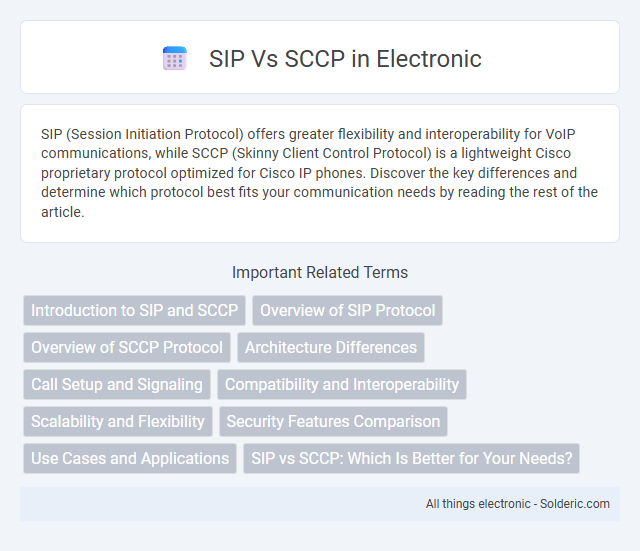SIP (Session Initiation Protocol) offers greater flexibility and interoperability for VoIP communications, while SCCP (Skinny Client Control Protocol) is a lightweight Cisco proprietary protocol optimized for Cisco IP phones. Discover the key differences and determine which protocol best fits your communication needs by reading the rest of the article.
Comparison Table
| Feature | SIP (Session Initiation Protocol) | SCCP (Skinny Client Control Protocol) |
|---|---|---|
| Protocol Type | Open, text-based signaling protocol | Proprietary, binary signaling protocol |
| Developed By | IETF (Internet Engineering Task Force) | Cisco Systems |
| Compatibility | Multi-vendor support, widely interoperable | Primarily Cisco devices |
| Transport Protocols | UDP, TCP, TLS | TCP only |
| Scalability | Highly scalable for large deployments | Limited scalability, optimized for Cisco Unified Communications |
| Media Negotiation | Uses SDP (Session Description Protocol) | Embedded in protocol messages |
| Use Case | VoIP, video conferencing, presence, instant messaging | Cisco IP Phones and call control in Cisco Unified Communications |
| Security | Supports TLS and SRTP for secure signaling and media | Limited security features, relies on network security |
| Extensibility | Highly extensible with numerous RFCs and enhancements | Limited extensibility due to proprietary nature |
Introduction to SIP and SCCP
Session Initiation Protocol (SIP) is a widely adopted signaling protocol used for initiating, maintaining, and terminating real-time communication sessions in IP-based networks, supporting voice, video, and messaging applications. Skinny Client Control Protocol (SCCP), developed by Cisco, is a lightweight signaling protocol primarily used in Cisco Unified Communications environments for controlling IP phones and managing call signaling. SIP's open standard nature facilitates interoperability across multiple vendors, whereas SCCP is proprietary and optimized for Cisco devices.
Overview of SIP Protocol
SIP (Session Initiation Protocol) is a signaling protocol widely used for initiating, maintaining, and terminating real-time communication sessions in IP networks, including voice, video, and messaging applications. SIP operates at the application layer, enabling multimedia communication by establishing sessions between endpoints through request and response messages. Unlike SCCP (Skinny Call Control Protocol), SIP is more versatile, standardized, and supports a broader range of multimedia services, making it essential for your unified communications infrastructure.
Overview of SCCP Protocol
SCCP (Skinny Client Control Protocol) is a proprietary protocol developed by Cisco for call signaling and device control in IP telephony networks. It operates primarily in Cisco Unified Communications environments, enabling communication between IP phones and call managers by facilitating session establishment, control, and termination. SCCP's lightweight design optimizes bandwidth and processing resources, making it well-suited for Cisco-centric VoIP deployments compared to the more widely adopted standard SIP (Session Initiation Protocol).
Architecture Differences
SIP (Session Initiation Protocol) uses a decentralized architecture where endpoints directly communicate for session setup, offering flexibility and scalability for VoIP networks. SCCP (Skinny Client Control Protocol) relies on a centralized architecture with Cisco CallManager managing call control and signaling, which simplifies endpoint design but increases dependence on the call agent. This architectural difference impacts deployment complexity, with SIP supporting multi-vendor environments and SCCP optimized for Cisco-centric setups.
Call Setup and Signaling
SIP (Session Initiation Protocol) uses text-based signaling to establish, modify, and terminate multimedia sessions, offering flexibility and interoperability across IP networks. SCCP (Skinny Call Control Protocol) employs a lightweight, binary protocol primarily designed for Cisco IP phones, enabling rapid call setup with minimal overhead. While SIP supports a broader range of services and devices, SCCP's efficient signaling is optimized for Cisco environments, impacting call setup latency and scalability.
Compatibility and Interoperability
SIP (Session Initiation Protocol) offers broad compatibility across a wide range of devices and platforms due to its open standard nature, enabling seamless interoperability in multi-vendor environments. SCCP (Skinny Client Control Protocol), developed by Cisco, is tightly integrated within Cisco's ecosystem, providing optimized communication but limited compatibility with non-Cisco equipment. For your VoIP deployment, choosing SIP ensures greater flexibility and future-proofing by supporting diverse hardware and software systems.
Scalability and Flexibility
SIP (Session Initiation Protocol) offers superior scalability due to its decentralized architecture, enabling easy integration with multiple devices and platforms across various networks. SCCP (Skinny Client Control Protocol) relies on centralized control through Cisco Call Managers, which limits flexibility and scalability to Cisco-specific environments. SIP supports a broad range of endpoints and vendors, providing enhanced adaptability for expanding communication infrastructures.
Security Features Comparison
SIP (Session Initiation Protocol) offers robust security features including TLS encryption for signaling, SRTP for media stream protection, and extensive authentication mechanisms to prevent unauthorized access. SCCP (Skinny Client Control Protocol), primarily used in Cisco environments, provides limited security capabilities with basic authentication and relies heavily on network-level protections such as VPNs or firewalls for safeguarding communication. For your VoIP deployment, SIP's comprehensive security framework ensures stronger defense against eavesdropping, replay attacks, and tampering compared to SCCP's more constrained security measures.
Use Cases and Applications
SIP (Session Initiation Protocol) is widely used for VoIP communications, video conferencing, and unified communications due to its flexibility and interoperability with various devices and platforms. SCCP (Skinny Client Control Protocol) is primarily deployed in Cisco VoIP telephony systems, offering tight integration with Cisco CallManager for reliable voice call control within enterprise environments. SIP supports broader applications including IP telephony, instant messaging, and multimedia distribution, while SCCP is typically confined to Cisco-specific hardware and voice call management.
SIP vs SCCP: Which Is Better for Your Needs?
SIP (Session Initiation Protocol) offers greater flexibility and interoperability across different vendors and devices, making it ideal for scalable VoIP solutions. SCCP (Skinny Client Control Protocol) provides tighter integration and better call control with Cisco equipment, ensuring optimized performance in Cisco-centric environments. Choosing between SIP and SCCP depends on your infrastructure compatibility, desired scalability, and vendor preference.
SIP vs SCCP Infographic

 solderic.com
solderic.com